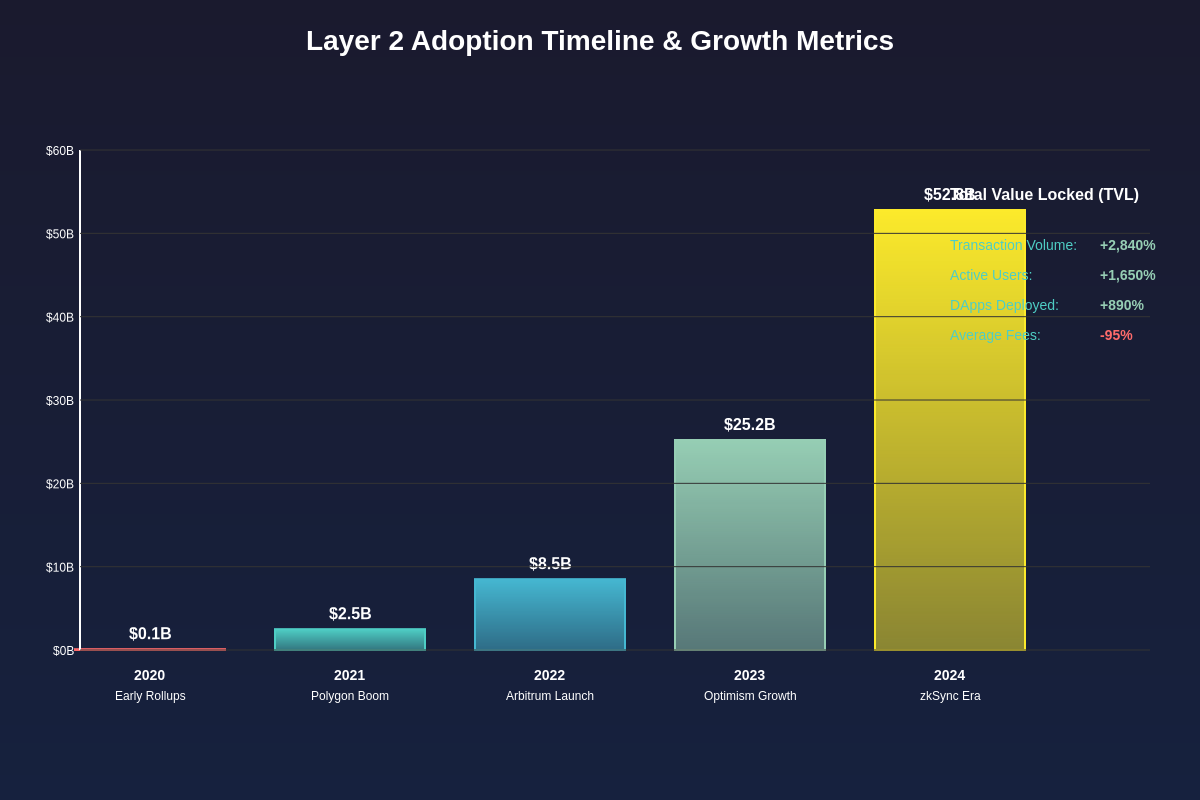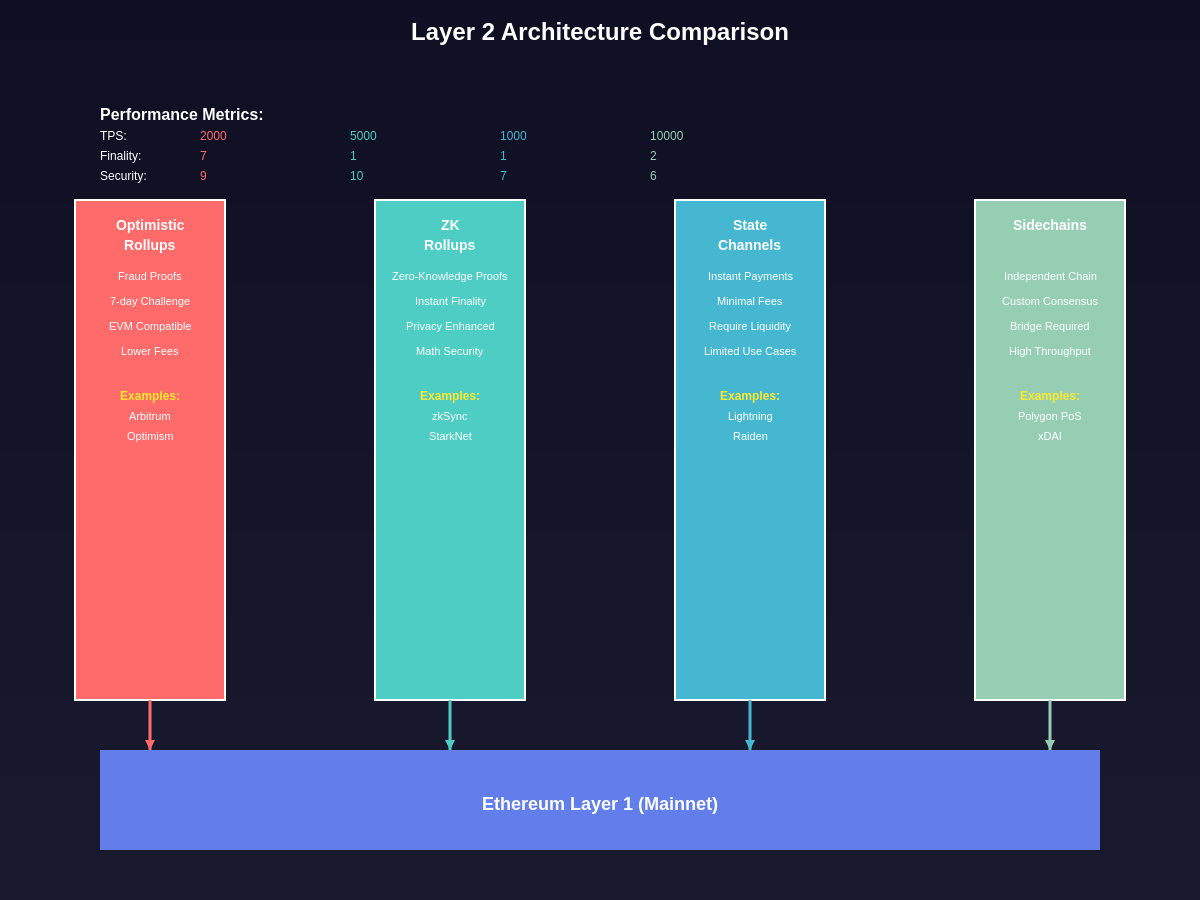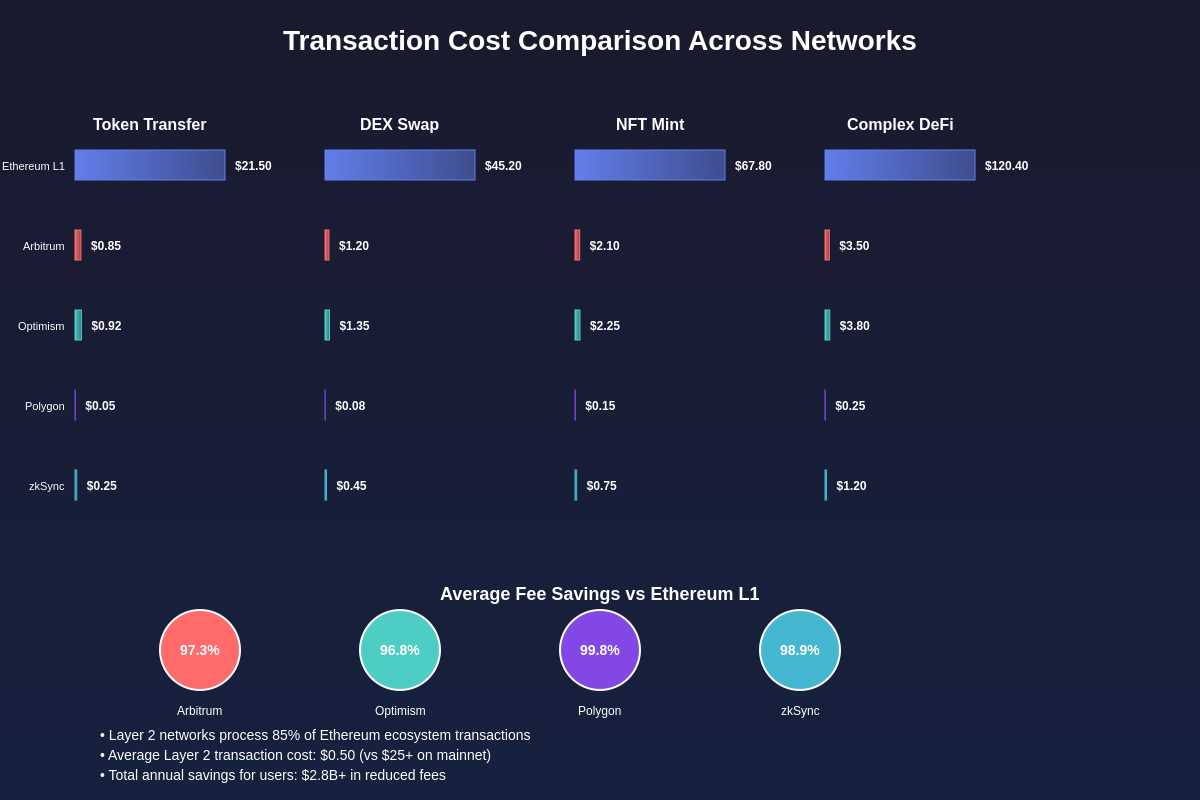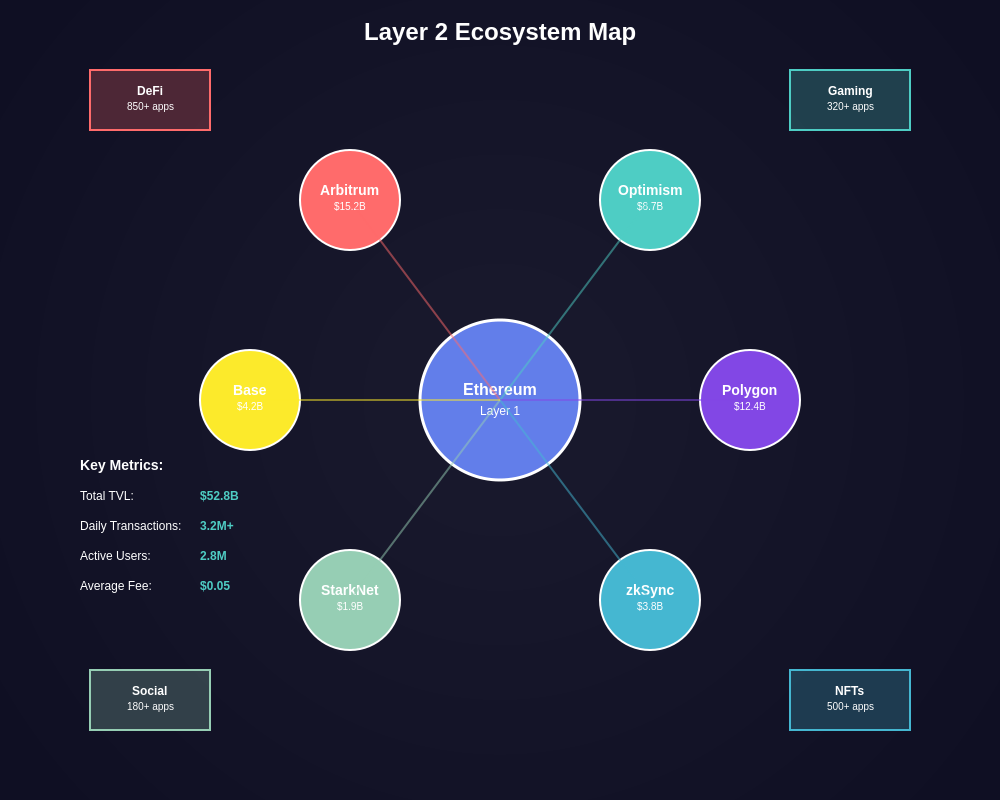Advanced TradingView analysis and Layer 2 metrics tracking
The Scaling Revolution Transforming Ethereum
Ethereum’s Layer 2 ecosystem has experienced unprecedented growth throughout 2024, with total value locked across Layer 2 networks surpassing $50 billion and transaction volumes reaching new all-time highs that demonstrate the increasing maturity and adoption of these scaling solutions. The momentum behind Layer 2 technologies represents a fundamental shift in how developers and users interact with the Ethereum ecosystem, offering solutions to the network’s most persistent challenges while maintaining the security guarantees and decentralization principles that make Ethereum valuable.

The surge in Layer 2 adoption reflects not merely technological advancement but a comprehensive ecosystem transformation that encompasses infrastructure development, user experience improvements, institutional adoption, and the emergence of new economic models that were previously impossible on Ethereum’s base layer. Major corporations, decentralized applications, and individual users are increasingly choosing Layer 2 solutions as their primary interaction layer with Ethereum, driven by dramatically reduced transaction costs, faster settlement times, and improved user experiences that rival traditional web applications.
This transformation has been accelerated by significant developments including the successful deployment of optimistic rollups and zero-knowledge rollups, the introduction of sophisticated bridging mechanisms, the launch of Layer 2-native applications that leverage unique scaling properties, and the growing institutional recognition of Layer 2 networks as legitimate and secure scaling solutions. The confluence of these factors has created a positive feedback loop where improved infrastructure attracts more users and developers, which in turn drives further investment and innovation in Layer 2 technologies.
Historical Context and Evolution of Ethereum Scaling
The journey toward Ethereum Layer 2 solutions began as early as 2017 when network congestion and high transaction fees during the initial ICO boom highlighted the urgent need for scaling solutions that could maintain Ethereum’s security properties while dramatically increasing throughput. Early scaling attempts included state channels, plasma chains, and sidechains, each offering different trade-offs between security, scalability, and decentralization that provided valuable lessons for the development of modern Layer 2 solutions.
State channels, exemplified by projects like Raiden Network and Lightning Network adaptations, offered instant transactions and minimal fees but required significant upfront capital lockup and complex channel management that limited their applicability to specific use cases. Plasma chains provided greater scalability but faced challenges with data availability and exit procedures that made them unsuitable for general-purpose applications requiring complex smart contract interactions.
The breakthrough came with the development of rollup technologies that could inherit Ethereum’s security while processing transactions off-chain and posting compressed transaction data to the main chain. Optimistic rollups, pioneered by projects like Optimism and Arbitrum, achieved this through fraud proofs and challenge periods, while zero-knowledge rollups like Polygon zkEVM and StarkNet leveraged cryptographic proofs to ensure transaction validity without requiring extended challenge periods.
The evolution of Layer 2 solutions has been marked by continuous innovation in areas including data compression techniques, proof generation optimization, cross-chain communication protocols, and user experience improvements that have gradually eliminated the friction associated with moving between Layer 1 and Layer 2 environments. These technological advances have been accompanied by significant ecosystem development including wallet integrations, developer tools, infrastructure services, and educational resources that have lowered the barriers to Layer 2 adoption.
Technical Architecture and Innovation Breakthroughs
Modern Layer 2 solutions employ sophisticated technical architectures that balance security, scalability, and decentralization through innovative approaches to transaction processing, data availability, and settlement finality. Optimistic rollups operate under the assumption that transactions are valid by default, using fraud proofs and challenge periods to detect and correct invalid state transitions, while zero-knowledge rollups provide mathematical guarantees of transaction validity through cryptographic proofs that can be verified quickly and efficiently.

The technical sophistication of current Layer 2 solutions extends beyond basic transaction processing to include advanced features like account abstraction, native meta-transactions, sophisticated fee markets, and interoperability protocols that enable seamless interaction between different Layer 2 networks. These features represent significant innovations over Ethereum’s base layer functionality and demonstrate how Layer 2 solutions can serve not merely as scaling solutions but as platforms for entirely new categories of applications and user experiences.
Data availability solutions have emerged as a critical component of Layer 2 architecture, with different approaches including on-chain data posting, data availability committees, and emerging data availability layers that provide security guarantees while minimizing costs. The choice of data availability solution significantly impacts the security, cost, and decentralization properties of Layer 2 networks, leading to diverse approaches that cater to different application requirements and user preferences.
Advanced cryptographic techniques including polynomial commitments, multi-party computation, and recursive proof systems have enabled Layer 2 solutions to achieve previously impossible combinations of security, privacy, and scalability. These innovations continue to evolve rapidly, with research into areas like proof aggregation, universal circuits, and quantum-resistant cryptography promising even greater capabilities for future Layer 2 implementations.
Economic Impact and Fee Structure Revolution
The economic transformation enabled by Layer 2 solutions extends far beyond simple fee reduction to encompass entirely new economic models, business opportunities, and value creation mechanisms that were economically unfeasible on Ethereum’s base layer. Transaction fees on major Layer 2 networks typically range from $0.01 to $0.10, representing a reduction of 95-99% compared to Ethereum mainnet fees during periods of high congestion, making previously impossible use cases economically viable and opening cryptocurrency access to users in developing economies.

This dramatic fee reduction has enabled the emergence of micro-transaction economies, frequent trading strategies, complex multi-step DeFi operations, and social applications that require numerous small transactions to provide compelling user experiences. The economic accessibility provided by Layer 2 solutions has also democratized access to DeFi protocols, NFT markets, and other cryptocurrency applications that were previously restricted to users with significant capital due to high transaction costs.
The fee structure revolution extends beyond user-facing costs to include new business models for application developers, infrastructure providers, and network operators. Layer 2 networks often implement innovative fee sharing mechanisms, sequencer revenue models, and token economics that align incentives between different ecosystem participants while maintaining economic security and sustainable operations.
Comprehensive Layer 2 fee analysis and comparison tools provide real-time insights into the economic advantages of different Layer 2 solutions, helping users and developers make informed decisions about which networks best serve their specific requirements and cost constraints.
Major Layer 2 Networks and Their Unique Approaches
The Layer 2 ecosystem has evolved into a diverse landscape of specialized networks, each offering unique technical approaches, economic models, and application focuses that cater to different segments of the Ethereum user base. Arbitrum has established itself as a leading optimistic rollup with comprehensive EVM compatibility, robust developer tools, and significant institutional adoption, while maintaining a strong focus on decentralization and security that appeals to users prioritizing trustlessness over pure performance.

Optimism has differentiated itself through its commitment to public goods funding, innovative governance mechanisms, and close alignment with Ethereum’s values and roadmap, making it an attractive choice for applications and users who prioritize ecosystem alignment and long-term sustainability. The network’s retroactive public goods funding model has created new mechanisms for supporting open-source development and community building that extend beyond traditional token incentives.
Polygon has pursued a multi-pronged approach including proof-of-stake sidechains, zero-knowledge rollups, and standalone blockchain networks that provide different trade-offs between security and performance. This diverse approach allows Polygon to serve various use cases from high-throughput gaming applications to enterprise-grade financial services while maintaining strong connections to the Ethereum ecosystem.
Zero-knowledge rollup networks including StarkNet, Polygon zkEVM, and zkSync Era represent the cutting edge of Layer 2 technology, offering immediate finality, enhanced privacy properties, and theoretical unlimited scalability through proof recursion and aggregation. These networks are particularly attractive for applications requiring high security guarantees and those building privacy-preserving functionality that cannot be achieved on transparent blockchain networks.
Developer Ecosystem and Tooling Maturation
The maturation of Layer 2 developer ecosystems has been a critical factor in driving adoption, with comprehensive tooling suites, educational resources, and infrastructure services that rival and often exceed what is available for Ethereum mainnet development. Modern Layer 2 networks provide developers with sophisticated debugging tools, gas optimization analyzers, cross-chain development frameworks, and automated testing suites that significantly reduce the complexity of building scalable decentralized applications.
Developer experience improvements include seamless wallet integrations, automated bridging mechanisms, unified development environments that support multiple Layer 2 networks simultaneously, and sophisticated monitoring and analytics tools that provide deep insights into application performance and user behavior. These tools have eliminated many of the friction points that previously made Layer 2 development challenging and time-consuming.
The emergence of Layer 2-specific development frameworks and libraries has enabled developers to build applications that leverage unique Layer 2 capabilities including account abstraction, native meta-transactions, and advanced fee payment mechanisms. These frameworks abstract away the complexity of Layer 2 interactions while providing powerful primitives for building sophisticated user experiences that would be impossible or prohibitively expensive on Layer 1.
Educational initiatives and developer support programs provided by Layer 2 networks have accelerated ecosystem growth by providing comprehensive documentation, tutorial series, hackathon support, and direct technical assistance that lower the barriers to entry for developers new to Layer 2 technologies. These programs have been particularly effective at attracting developers from traditional web development backgrounds who are interested in blockchain technology but find Layer 1 development too complex or expensive.
Institutional Adoption and Enterprise Use Cases
Institutional adoption of Layer 2 solutions has accelerated dramatically as enterprises recognize the potential for blockchain technology to improve business processes while Layer 2 networks provide the scalability, cost-effectiveness, and user experience required for mainstream adoption. Major corporations are increasingly choosing Layer 2 networks for supply chain management, digital identity systems, payment processing, and customer engagement platforms that require blockchain’s transparency and immutability without the high costs and slow confirmation times of Layer 1 networks.
Financial institutions have been particularly active in Layer 2 adoption, using these networks for cross-border payments, trade finance, regulatory reporting, and internal settlement systems that benefit from blockchain technology’s auditability and programmability. The reduced transaction costs and faster settlement times provided by Layer 2 solutions make these applications economically viable while maintaining the security and regulatory compliance required for institutional use.
Enterprise-focused Layer 2 solutions have emerged to serve specific industry needs, offering features like private transaction pools, regulatory compliance tools, enterprise-grade support services, and integration capabilities with existing business systems. These specialized solutions demonstrate how Layer 2 technology can be adapted to serve diverse institutional requirements while maintaining interoperability with the broader Ethereum ecosystem.
The institutional adoption trend has been supported by the development of professional services, auditing capabilities, insurance products, and regulatory frameworks specifically designed for Layer 2 networks. These supporting services provide institutions with the risk management tools and compliance capabilities they require to deploy Layer 2 solutions in production environments serving millions of users and processing billions of dollars in transactions.
User Experience and Accessibility Improvements
The user experience revolution enabled by Layer 2 solutions extends beyond reduced fees and faster transactions to encompass fundamental improvements in how users interact with blockchain applications and manage their digital assets. Modern Layer 2 applications provide user experiences that rival traditional web applications while maintaining the benefits of decentralization, self-custody, and programmable money that make blockchain technology valuable.
Account abstraction capabilities available on many Layer 2 networks enable sophisticated user experience improvements including social recovery mechanisms, gasless transactions, subscription-based payment models, and complex authorization schemes that provide both enhanced security and improved usability. These features make blockchain applications accessible to users who are not familiar with traditional cryptocurrency concepts like private key management and gas fees.
Seamless bridging mechanisms and automated asset management tools have eliminated much of the complexity associated with moving assets between different networks, allowing users to interact with multi-chain applications without needing to understand the underlying technical details. Advanced wallet interfaces provide unified views of assets and transactions across multiple Layer 2 networks while handling the technical complexity of cross-chain operations behind the scenes.
Real-time Layer 2 network performance monitoring helps users choose optimal networks for their specific use cases based on current fees, confirmation times, and network congestion levels, ensuring the best possible user experience across different market conditions.
DeFi Innovation and New Financial Primitives
Layer 2 networks have become incubators for DeFi innovation, enabling new financial primitives and business models that were economically unfeasible on Ethereum mainnet due to high transaction costs and slow confirmation times. The reduced costs on Layer 2 networks have made frequent rebalancing, complex arbitrage strategies, and sophisticated yield farming economically viable, leading to more efficient markets and better capital allocation throughout the DeFi ecosystem.
Advanced DeFi protocols on Layer 2 networks leverage unique scaling properties to offer features like real-time settlement, dynamic fee structures, and complex multi-asset strategies that provide users with more sophisticated financial tools and better risk management capabilities. These innovations represent genuine advances over traditional DeFi protocols rather than simple ports of existing applications to different networks.
Cross-chain DeFi protocols have emerged to leverage liquidity and functionality across multiple Layer 2 networks, creating unified financial ecosystems that provide users with access to the best features and opportunities available across different scaling solutions. These protocols demonstrate how Layer 2 interoperability can create value that exceeds the sum of individual network capabilities.
The emergence of Layer 2-native DeFi protocols has led to experimentation with novel economic mechanisms including dynamic token emissions, cross-chain governance systems, and innovative liquidity mining programs that align incentives across multiple networks while maintaining decentralized governance and community control. These experiments are producing valuable insights that influence the broader evolution of DeFi protocols and tokenomics design.
Gaming and NFT Applications Leading Adoption
Gaming applications have emerged as a major driver of Layer 2 adoption, with blockchain games requiring thousands of transactions per user session making them natural fits for low-cost, high-throughput Layer 2 networks. The gaming industry’s embrace of Layer 2 solutions demonstrates how blockchain technology can enhance traditional gaming experiences through true digital asset ownership, decentralized marketplaces, and play-to-earn mechanics that provide real economic value to players.
NFT ecosystems on Layer 2 networks have evolved beyond simple collectibles to encompass utility tokens, gaming assets, virtual real estate, and complex programmable digital objects that can interact with smart contracts and other blockchain applications. The reduced minting and trading costs on Layer 2 networks have democratized NFT creation and trading, enabling artists and creators who were previously priced out of Ethereum mainnet to participate in blockchain-based digital economies.
The emergence of sophisticated gaming economies on Layer 2 networks has created new categories of economic activity including professional gaming, digital asset trading, virtual world development, and game-as-a-service business models that generate sustainable revenue streams for developers while providing genuine value to players. These applications demonstrate how Layer 2 technology can enable entirely new industries and economic relationships.
Advanced gaming infrastructure on Layer 2 networks includes features like instant asset transfers, complex multi-party interactions, sophisticated reward systems, and integration with traditional gaming platforms that provide seamless experiences for users transitioning from traditional gaming to blockchain-based alternatives. These infrastructure developments are critical for mainstream gaming adoption and demonstrate the maturity of Layer 2 technology stacks.
Interoperability and Cross-Chain Infrastructure
The development of sophisticated interoperability solutions has been crucial for Layer 2 adoption, enabling seamless asset transfers, unified user experiences, and complex multi-chain applications that leverage the unique capabilities of different networks. Modern bridging solutions provide near-instant transfers with minimal fees while maintaining security guarantees that protect users from the risks associated with cross-chain operations.
Cross-chain communication protocols have evolved beyond simple asset transfers to enable complex interactions including cross-chain smart contract calls, unified liquidity pools, and decentralized applications that span multiple Layer 2 networks. These capabilities demonstrate how interoperability infrastructure can create network effects that benefit all participating chains while providing users with access to the best features and opportunities available across the ecosystem.
The emergence of universal standards for Layer 2 interoperability has accelerated development of multi-chain applications and infrastructure services that provide consistent experiences across different networks. These standards reduce development complexity while ensuring that applications can easily integrate new Layer 2 networks as they become available, creating a more sustainable and scalable ecosystem architecture.
Advanced interoperability solutions include features like atomic cross-chain swaps, unified governance systems, shared security models, and cross-chain identity management that enable sophisticated multi-chain applications while maintaining the security and decentralization properties that make blockchain technology valuable. These solutions represent significant technical achievements that were theoretical concepts just a few years ago.
Regulatory Landscape and Compliance Developments
The regulatory landscape for Layer 2 solutions has evolved to provide greater clarity and acceptance as regulators recognize these networks as legitimate scaling solutions rather than separate blockchain networks requiring distinct regulatory treatment. This regulatory clarity has been crucial for institutional adoption and has enabled the development of compliance tools and professional services specifically designed for Layer 2 environments.
Compliance infrastructure for Layer 2 networks includes sophisticated transaction monitoring systems, regulatory reporting tools, know-your-customer integration capabilities, and audit trails that meet the requirements of traditional financial regulators while preserving the decentralized and permissionless properties that make blockchain technology innovative. These tools demonstrate how regulatory compliance and decentralization can coexist in practical implementations.
The development of regulatory frameworks specifically designed for Layer 2 networks has provided clarity for developers, users, and service providers while establishing standards for security, transparency, and user protection that benefit the entire ecosystem. These frameworks balance innovation encouragement with appropriate consumer protection and financial stability considerations.
International coordination on Layer 2 regulation has improved as regulators recognize the global nature of these networks and the need for consistent standards that prevent regulatory arbitrage while encouraging innovation. This coordination has been facilitated by the technical similarities between different Layer 2 solutions, which enable more standardized regulatory approaches than were possible for the diverse landscape of early blockchain networks.
Environmental Impact and Sustainability Advantages
Layer 2 solutions provide significant environmental advantages over both Ethereum mainnet and alternative blockchain networks by dramatically reducing the energy consumption per transaction while maintaining security through Ethereum’s increasingly efficient proof-of-stake consensus mechanism. The environmental benefits of Layer 2 adoption have become an important factor for environmentally conscious users and institutions considering blockchain technology adoption.
The energy efficiency of Layer 2 networks stems from their ability to process thousands of transactions using the same amount of Ethereum mainnet energy required for a single transaction, creating exponential improvements in energy efficiency as Layer 2 adoption increases. This efficiency improvement is particularly important for applications requiring high transaction volumes and for users concerned about the environmental impact of their blockchain activity.
Sustainability initiatives within the Layer 2 ecosystem include carbon offset programs, renewable energy commitments, and the development of environmental impact measurement tools that provide transparency about the ecological effects of different network choices. These initiatives demonstrate the ecosystem’s commitment to environmental responsibility and help users make informed decisions about their blockchain activity.
The environmental advantages of Layer 2 solutions have become important factors in institutional adoption decisions, with many corporations and organizations prioritizing environmentally sustainable blockchain solutions in their technology selection processes. This trend has created additional momentum for Layer 2 adoption while encouraging continued innovation in energy-efficient blockchain technologies.
Future Roadmap and Technological Developments
The future roadmap for Layer 2 solutions includes ambitious technological developments that promise even greater scalability, security, and functionality improvements that will further accelerate adoption and enable new categories of applications. Zero-knowledge proof technology continues to advance rapidly, with developments in proof recursion, universal circuits, and quantum-resistant cryptography that will provide Layer 2 networks with unprecedented capabilities.
Ethereum’s upcoming upgrades including proto-danksharding and full danksharding will provide Layer 2 networks with dedicated data availability space that will further reduce costs and increase throughput while maintaining security guarantees. These upgrades represent fundamental improvements to Ethereum’s architecture specifically designed to support Layer 2 scaling solutions and demonstrate the ecosystem’s commitment to multi-layer scaling approaches.
The development of Layer 3 solutions built on top of Layer 2 networks promises even greater specialization and optimization for specific use cases, with application-specific rollups that can provide tailored functionality, economics, and governance models while inheriting security from lower layers. These developments will enable even greater diversity in blockchain application design and user experience optimization.
Advanced interoperability solutions including shared sequencing, universal settlement layers, and cross-chain zero-knowledge proofs will create more unified multi-chain ecosystems that provide users with seamless experiences while maintaining the benefits of network specialization and competition. These developments represent the maturation of blockchain technology into a truly scalable and user-friendly infrastructure layer for global digital applications.
Professional Layer 2 analysis and performance tracking tools
Investment and Market Dynamics
The investment landscape for Layer 2 solutions has matured significantly, with dedicated venture capital funds, institutional investors, and strategic partnerships that recognize the fundamental importance of scaling solutions for blockchain adoption. Investment in Layer 2 infrastructure, applications, and supporting services has exceeded billions of dollars, demonstrating strong confidence in the long-term viability and growth potential of these technologies.
Market dynamics for Layer 2 tokens and ecosystem projects have evolved to reflect the underlying utility and adoption metrics rather than purely speculative factors, with investors increasingly focusing on fundamentals like transaction volume, developer activity, total value locked, and user growth rates. This maturation has created more stable and sustainable market conditions that support long-term ecosystem development.
The emergence of Layer 2-focused investment products including exchange-traded funds, index tokens, and structured products has provided traditional investors with exposure to Layer 2 growth while contributing to market liquidity and price discovery. These products demonstrate the mainstream financial industry’s recognition of Layer 2 solutions as a distinct and valuable investment category.
Strategic partnerships between Layer 2 networks and traditional enterprises, technology companies, and financial institutions have created new avenues for adoption and revenue generation while providing validation for institutional use cases. These partnerships often include technical integration, joint product development, and co-marketing arrangements that accelerate ecosystem growth and mainstream adoption.
Challenges and Risk Considerations
Despite their significant advantages, Layer 2 solutions face ongoing challenges including technical risks, economic sustainability concerns, and competitive pressures that must be addressed for continued growth and adoption. Technical risks include potential bugs in complex rollup implementations, challenges with proof generation and verification, and the ongoing development of interoperability solutions that maintain security while providing seamless user experiences.
Economic sustainability challenges include the need to balance low user fees with adequate revenue for network operations, sequencer economics, and token value accrual mechanisms that align long-term incentives between different ecosystem participants. These challenges are particularly acute for newer networks that must compete with established solutions while building sustainable business models.
Centralization risks in sequencer operations, proof generation, and bridge management represent ongoing concerns that Layer 2 networks are actively addressing through decentralization roadmaps, governance systems, and technical solutions that distribute control while maintaining operational efficiency. The balance between decentralization and performance remains a key challenge for the ecosystem.
Regulatory uncertainty in some jurisdictions continues to create challenges for Layer 2 adoption, particularly for institutional use cases that require clear legal frameworks and compliance capabilities. However, the overall trend toward regulatory clarity and acceptance suggests that these challenges will diminish over time as the technology matures and regulatory frameworks evolve.
Disclaimer: This article is for informational purposes only and does not constitute financial advice. Cryptocurrency investments carry significant risks, including the potential for total loss of capital. The information presented here is based on current market conditions and technological developments, which may change rapidly. Readers should conduct their own research and consult with qualified financial advisors before making investment decisions. The author and publisher are not responsible for any financial losses that may occur from acting on the information provided in this article. Past performance does not guarantee future results, and all cryptocurrency investments should be considered highly speculative and suitable only for investors who can afford to lose their entire investment.